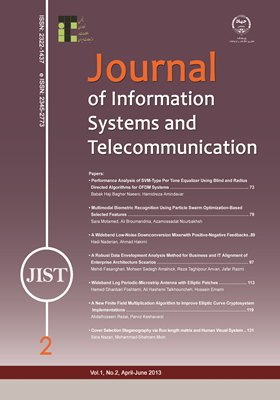-
-
List of Articles
-
Open Access Article
1 - Performance Analysis of SVM-Type Per Tone Equalizer Using Blind and Radius Directed Algorithms for OFDM Systems
Babak Haji Bagher Naeeni -
Open Access Article
2 - Multimodal Biometric Recognition Using Particle Swarm Optimization-Based Selected Features
Sara Motamed Ali Broumandnia Azam sadat Nourbakhsh -
Open Access Article
3 - A Wideband Low-Noise Downconversion Mixerwith Positive-Negative Feedbacks
Hadi Naderian Ahmad Hakimi -
Open Access Article
4 - A Robust Data Envelopment Analysis Method for Business and IT Alignment of Enterprise Architecture Scenarios
Mehdi Fasanghari Mohsen Sadegh Amalnick Reza Taghipour Anvari Jafar Razmi -
Open Access Article
5 - Wideband Log Periodic-Microstrip Antenna with Elliptic Patches
hamed ghanbari foshtami Ali Hashemi Talkhouncheh Hossein Emami -
Open Access Article
6 - A New Finite Field Multiplication Algorithm to Improve Elliptic Curve Cryptosystem Implementations
Abdalhossein Rezai Parviz Keshavarzi -
Open Access Article
7 - Cover Selection Steganography Via Run Length Matrix and Human Visual System
Sara Nazari Mohammad Shahram Moin
-
The rights to this website are owned by the Raimag Press Management System.
Copyright © 2017-2025







